Changes in Vegetation Growth Dynamics and Relations with Climate in Inner Mongolia under More Strict Multiple Pre-Processing (2000–2018)
Abstract
1. Introduction
2. Data and Methods
2.1. Study Area
2.2. Data Sources
2.3. Data Processing
2.3.1. EVI Data Processing
2.3.2. Meteorological Data Processing
- (a)
- Perform homogeneity test on meteorological data to eliminate unavailable data.
- (b)
- In order to avoid uncertain factors caused by excessive differences in altitude of meteorological stations, stratified randomization is used to randomly group, interpolate and verify meteorological stations as follows: according to the altitude of the meteorological stations, they are divided into three groups—below 1000 m, 1000–2000 m and over 2000 m. Each group randomly selects 90% of the stations as the experimental group and the remaining 10% as the control group, and then combines all the experimental groups and the control groups. All the meteorological station data of the experimental group are used in the interpolation of Co-kriging, Kriging, IDW and TPS. The cross-validation is performed with the remaining 10% of station data of the control group. In this way, the stratified random verification can be performed 10,000 times, and the interpolation results are compared with the mean value of relative error in the control group so that we can find the most accurate interpolation method.
- (c)
- All the data from the 110 stations are interpolated with the determined interpolation method, and the results of the interpolation are resampled to perform a relative error test (annual mean value of relative error ≤ 10%) with verification dataset from the surface meteorological grid.
2.4. Methods
2.4.1. Trend Analytical Method
2.4.2. Standard Deviation Analysis
2.4.3. Grey Relational Analysis
2.4.4. Lag Analysis on the Pixel Scale
3. Results
3.1. Inter-annual Change and Spatial Distribution Pattern of EVI in the Growing Season
3.1.1. Inter-annual Change of EVI in the Growing Season
3.1.2. Characteristics of Spatial Distribution of Multi-year Mean EVI
3.2. Temporal and Spatial Change Rules of EVI in the Growing Season
3.3. Inter-annual Change Trends of Climatic Factors in Each Period
3.4. Lag Analysis of EVI in the Growing Season to Climatic Factors
3.4.1. Analysis of EVI’s Lag Time of Response to Climatic Factors on the Pixel Scale
3.4.2. Analysis of EVI’s Response Degree to Climatic Factors on the Pixel Scale
3.4.3. Zoning for EVI Changes Based on the Dominant Driving Climatic Factors
4. Analysis and Discussion
5. Conclusions
- From 2000 to 2018, the mean EVI of the vegetation in the growing season of IMAR is 0.280, which is significantly different in space, showing a distribution pattern that decreases from north to south and east to west. The change rate from east to west is 0.25/10° E and 0.23/10° N from north to south. The mean value of EVI in IMAR shows a rising trend during the 19 years, with a growth rate of 0.031/10a. Areas with significant improvement and obvious improvement account for 14.7% and 25.9%, respectively, of the study area, while areas with significant degradation and obvious degradation account for 0.38% and 0.39%, respectively, of the study area.
- Different vegetation types in different ecological environments have independent dominant factors and temporal and spatial distribution rules of response speed and response degree to water and heat. On the whole, the response speed and response degree to climate factors are higher in forests than in grasslands.
- The lag time of vegetation’s response to precipitation, air temperature and relative humidity in IMAR is mostly within 2 months, and the percentage of area is 68.3%, 55.3% and 71.7%, respectively. The response time of vegetation to precipitation shows a significant positive correlation with the altitude. The more humid the climate is, the faster the vegetation responds to air temperature changes; the higher the latitude is, the shorter the lag time of vegetation’s response to changes in relative humidity.
- Vegetation types and altitude gradients are the two most important factors that affect the degree of vegetation’s response to climate factors. It is worth noting that at an elevation of 2500 m, the dominant factor in vegetation growth is changed by the hydrothermal combination in the environment. Below 2500 m, the correlation between vegetation EVI and precipitation and relative humidity is the highest in the study area. The moisture-dominated factor affects vegetation growth in the region, while in areas above 2500 m, the correlation between EVI and air temperature in the study area exceeds precipitation and relative humidity. In areas with relatively high elevation, vegetation growth is more dependent on air temperature.
- The area where EVI changes are mainly driven by precipitation accounts for 53.7% of the study area, far greater than that by air temperature (15.4%) and relative humidity (30.9%). The EVI has the closest relationship with precipitation, followed by relative humidity and then air temperature. However, the growth and change of vegetation are not limited to the change of a single climatic factor, but affected by multiple climatic factors.
Author Contributions
Funding
Acknowledgments
Conflicts of Interest
References
- Walker, B.; Steffen, W. IGBP Science No.1: A synthesis of GCTE and related research. Stockholm IGBP 1997, 1–24. [Google Scholar]
- Parmesan, C.; Yohe, G. A globally coherent fingerprint of climate change impacts across natural systems. Nature 2003, 421, 37–42. [Google Scholar] [CrossRef] [PubMed]
- Xin, Z.B.; Xu, J.X.; Zheng, W. Spatiotemporal variations of vegetation cover on the Chinese Loess Plateau (1981-2006): Impacts of climate changes and human activities. Sci. China Ser. D 2008, 51, 67–78. [Google Scholar] [CrossRef]
- Liu, J.H.; Gao, J.X. Effects of climate and land use change on the change of vegetation coverage in farming-pastoral ecotone of northern China. Chin. J. Appl. Ecol. 2008, 19, 2016–2022. [Google Scholar]
- Gan, C.Y.; Wang, X.Z.; Li, B.S.; Liang, Z.X.; Li, Z.W.; Wen, X.H. Changes of vegetation coverage during recent 18 years in Lianjiang river watershed. Sci. Geogr. Sin. 2011, 31, 1019–1024. [Google Scholar]
- Tucker, C.J. Red and photographic infrared linear combination for monitoring vegetation. Remote Sens. Environ. 1979, 8, 127–150. [Google Scholar] [CrossRef]
- He, D.; Yi, G.H.; Zhang, T.B.; Miao, J.Q.; Li, J.J.; Bie, X.J. Temporal and spatial characteristics of EVI and its response to climatic factors in recent 16 years based on grey relational analysis in Inner Mongolia Autonomous Region, China. Remote Sens. 2018, 10, 961. [Google Scholar] [CrossRef]
- Pettorelli, N.; Vik, J.O.; Mysterud, A.; Gaillard, J.M.; Tucker, C.J.; Stenseth, N.C. Using the satellite-derived NDVI to assess ecological responses to environmental change. Trends Ecol. Evol. 2005, 20, 503–510. [Google Scholar] [CrossRef]
- Sun, Y.L.; Guo, P.; Yan, X.D.; Zhao, T.B. Dynamics of vegetation cover and its relationship with climate change and human activities in Inner Mongolia. J. Nat. Res. 2010, 25, 407–414. [Google Scholar]
- Shi, Z.J.; Gao, J.X.; Xu, L.H.; Feng, C.Y.; Lv, S.H.; Shang, J.X. Effect of vegetation on changes of temperature and precipitation in Inner Mongolia, China. Ecol. Envirn. Sci. 2011, 20, 1594–1601. [Google Scholar]
- Ji, L.; Peters, A.J. Assessing vegetation response to drought in the northern great plains using vegetation and drought indices. Remote Sens. Environ. 2003, 87, 85–98. [Google Scholar] [CrossRef]
- Huang, X.; Zhang, T.B.; Yi, G.H.; He, D.; Zhou, X.B.; Li, J.J.; Bie, X.J.; Miao, J.Q. Dynamic changes of NDVI in the growing season of the Tibetan Plateau during the past 17 years and its response to climate change. Int. J. Environ. Res. Public Health 2019, 16, 3452. [Google Scholar] [CrossRef] [PubMed]
- Chen, Y.L.; Luo, Y.M.; Mo, W.H.; Mo, J.F.; Huang, Y.L.; Ding, M.H. Differences between MODIS NDVI and MODIS EVI in response to climatic factors. J. Nat. Res. 2014, 29, 1802–1812. [Google Scholar]
- Cui, L.L.; Shi, J.; Xiao, F.J.; Fan, W.Y. Variation trends in vegetation NDVI and its correlation with climatic factors in Eastern China. Res. Sci. 2010, 32, 124–131. [Google Scholar]
- Liu, J.H.; Gao, J.X.; Wang, W.J. Variations of vegetation coverage and its relations to global climate changes on the Tibetan Plateau during 1981–2005. J. Mt. Sci.-Engl. 2013, 31, 234–242. [Google Scholar]
- Camberlin, P.; Martiny, N.; Philippon, N.; Richard, Y. Determinants of the interannual relationships between remote sensed photosynthetic activity and rainfall in tropical Africa. Remote Sens. Environ. 2007, 106, 199–216. [Google Scholar] [CrossRef]
- Wardlow, B.D.; Egbert, S.L. Large-area crop mapping using time-series MODIS 250m NDVI data: An assessment for the U.S. central great plains. Remote Sens. Environ. 2008, 112, 1096–1116. [Google Scholar] [CrossRef]
- Piao, S.L.; Wang, X.H.; Ciais, P.; Zhu, B. Changes in satellite-derived vegetation growth trend in temperate and boreal Eurasia from 1982 to 2006. Glob. Chang. Biol. 2011, 17, 3228–3239. [Google Scholar] [CrossRef]
- Karlsen, S.R.; Tolvanen, A.; Kubin, E.; Poikolainen, J. MODIS-NDVI-based mapping of the length of the growing season in northern Fennoscandia. Int. J. Appl. Earth Obs. 2008, 10, 253–266. [Google Scholar] [CrossRef]
- Raynolds, M.K.; Comiso, J.C.; Balser, A.; Verbyla, D. Relationship between satellite-derived land surface temperatures, arctic vegetation types, and NDVI. Remote Sens. Environ. 2008, 112, 1884–1894. [Google Scholar] [CrossRef]
- Wang, X.H.; Piao, S.L.; Ciais, P.; Li, J.S.; Friedlingstein, P.; Koven, C.D.; Chen, A. Spring temperature change and its implication in the change of vegetation growth in North America from 1982 to 2006. Proc. Natl. Acad. Sci. USA. 2011, 108, 1240–1245. [Google Scholar] [CrossRef] [PubMed]
- Li, J.; Zhang, C.Q.; Zhang, J. The lag response of the growth dynamics of dominant grasses to meteorological factors in typical steppe of Inner Mongolia. Acta Agrestia Sin. 2017, 25, 267–272. [Google Scholar]
- Klinge, M.; Dulamsuren, C.; Erasmi, S.; Karger, D.N.; Hauck, M. Climate effects on vegetation vitality at the treeline of boreal forests of Mongolia. Biogeosciences 2018, 15, 1–25. [Google Scholar] [CrossRef]
- Zhang, Q.Y.; Zhao, D.S.; Wu, S.H.; Dai, E.D. Research on vegetation changes and influence factors based on eco-geographical regions of Inner Mongolia. Sci. Geogr. Sin. 2013, 33, 594–601. [Google Scholar]
- Zhang, G.L.; Ou, Y.H.; Zhang, X.Z.; Zhou, C.P.; Xu, X.L. Vegetation change and its responses to climatic variation based on eco-geographical regions of Tibetan Plateau. Geogr. Res. 2010, 29, 2004–2016. [Google Scholar]
- Kong, D.D.; Zhang, Q.; Huang, W.L.; Gu, X.H. Vegetation phenology change in Tibetan Plateau from 1982 to 2013 and its related meteorological factors. Acta Geogr. Sci. 2017, 72, 39–52. [Google Scholar]
- Ballantyne, M.; Treby, D.L.; Quarmby, J.; Pickering, C.M. Comparing the impacts of different types of recreational trails on grey box grassy-woodland vegetation: Lessons for conservation and management. Aust. J. Bot. 2016, 64, 246–259. [Google Scholar] [CrossRef]
- Li, H.D.; Shen, W.S.; Cai, B.F.; Ji, D.; Zhang, X.Y. The coupling relationship between variations of NDVI and change of aeolian sandy land in the Yarlung Zangbo River Basin of Tibet, China. Acta Ecol. Sin. 2013, 33, 7729–7738. [Google Scholar]
- Zhu, W.Q.; Pan, Y.Z.; Long, Z.H.; Chen, Y.H.; Li, J.; Hu, H.B. Estimating net primary productivity of terrestrial vegetation based on GIS and RS: A case study in Inner Mongolia, China. J. Remote Sens. 2005, 9, 300–307. [Google Scholar]
- Sun, G.N.; Wang, M.H. Study on relation and distribution between vegetative coverage and land degradation in Inner Mongolia. J. Arid Land Res. Environ. 2008, 22, 140–144. [Google Scholar]
- Wang, Q.; Zhang, T.B.; Yi, G.H.; Chen, T.T.; Bie, X.J.; He, Y.X. Tempo-spatial variations and driving factors analysis of net primary productivity in the Hengduan mountain area from 2004 to 2014. Acta Ecol. Sin. 2017, 37, 1–13. [Google Scholar]
- Ding, M.J.; Zhang, Y.L.; Sun, X.M.; Liu, L.S.; Wang, Z.F. Spatiotemporal variation in alpine grassland phenology in the Qinghai-Tibetan Plateau from 1999 to 2009. Chin. Sci. Bull. 2012, 57, 3185–3194. [Google Scholar] [CrossRef]
- Roerink, G.J.; Menenti, M.; Verhoef, W. Reconstructing cloud free NDVI composites using Fourier analysis of time series. Int. J. Remote Sens. 2000, 21, 1911–1917. [Google Scholar] [CrossRef]
- Ren, S.; Yi, S.; Peichl, M.; Wang, X. Diverse responses of vegetation phenology to climate change in different grasslands in Inner Mongolia during 2000–2016. Remote Sens. 2018, 10, 17. [Google Scholar] [CrossRef]
- Zhang, W.; Ren, Z.; Yao, L.; Zhou, C.; Zhu, Y. Numerical modeling and prediction of future response of permafrost to different climate change scenarios on the Qinghai–Tibet Plateau. Int. J. Digit. Earth. 2016, 9, 442–456. [Google Scholar] [CrossRef]
- Wang, Z.Y.; Xu, R.Y.; Yang, H.; Ding, X.; Li, D.J. Impacts of climate change and human activities on vegetation dynamics in Inner Mongolia, 1981-2010. Prog. Geogr. 2017, 36, 1025–1032. [Google Scholar]
- Ugbaje, S.U.; Inakwu, O.A.; Thomas, F.A.B.; Li, J. Assessing the spatio-temporal variability of vegetation productivity in Africa: Quantifying the relative roles of climate variability and human activities. Int. J. Digit. Earth 2016, 10, 879–900. [Google Scholar]
- Borrelli, P.; Diodato, N.; Panagos, P. Rainfall erosivity in Italy: A national scale spatio-temporal assessment. Int. J. Digit. Earth 2016, 9, 835–850. [Google Scholar] [CrossRef]
- Meng, D.; Li, X.J.; Gong, H.L.; Qu, Y.T. Analysis of spatial-temporal change of NDVI and its climatic driving factors in Beijing-Tianjin-Hebei metropolis circle from 2001 to 2013. J. Geo-Inform. Sci. 2015, 17, 1001–1007. [Google Scholar]
- Wong, H.; Hu, B.Q.; Ip, W.C.; Xia, J. Change-point analysis of hydrological time series using grey relational method. J. Hydrol. 2006, 324, 323–338. [Google Scholar] [CrossRef]
- Yi, G.H.; Zhang, T.B. Delayed response of lake area change to climate change in siling co lake, Tibetan Plateau, from 2003 to 2013. Int. J. Environ. Res. Public Health 2015, 12, 886–900. [Google Scholar] [CrossRef] [PubMed]
- Mu, S.J.; Zhou, K.X.; Qi, Y.; Chen, Y.Z.; Fang, Y.; Zhu, C. Spatio-temporal patterns of precipitation-use efficiency of vegetation and their controlling factors in Inner Mongolia. Chin. J. Plant Ecol. 2014, 38, 1–16. [Google Scholar]
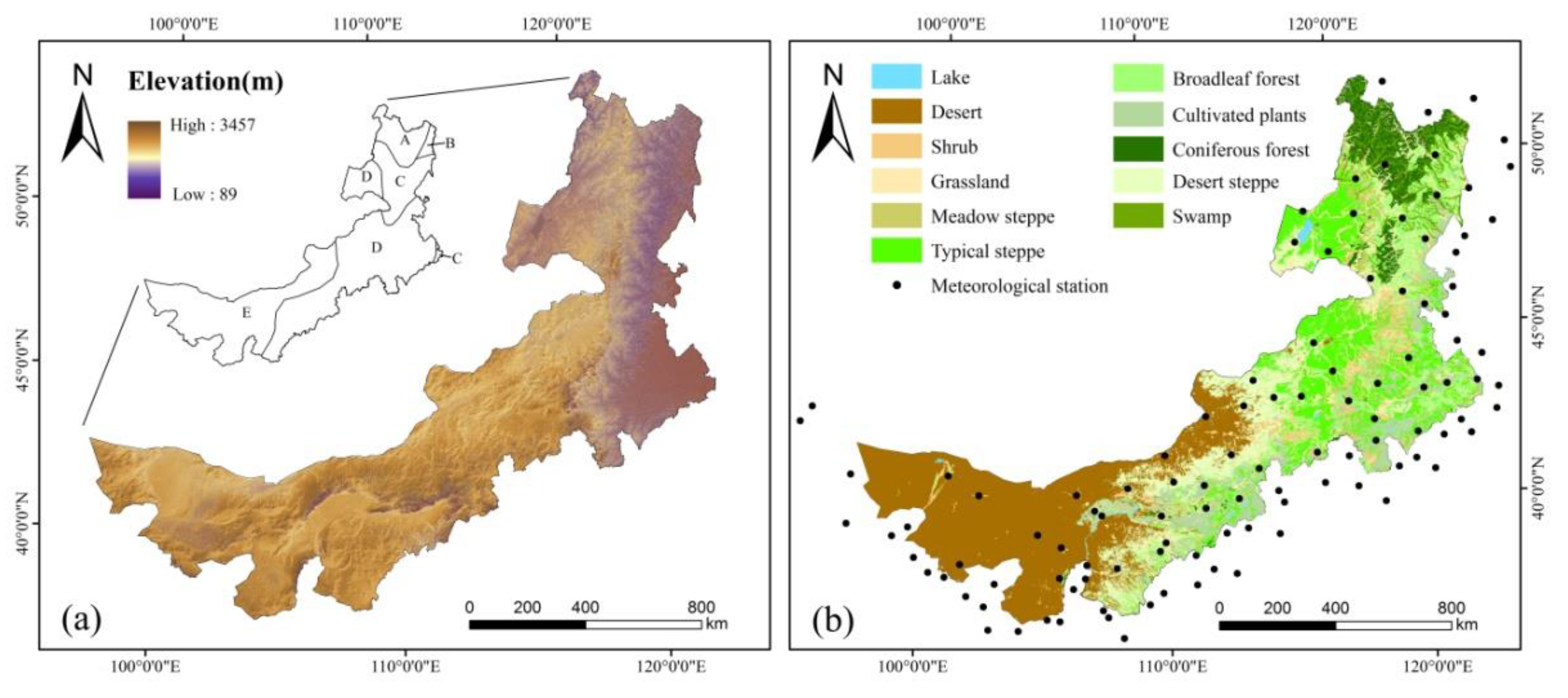

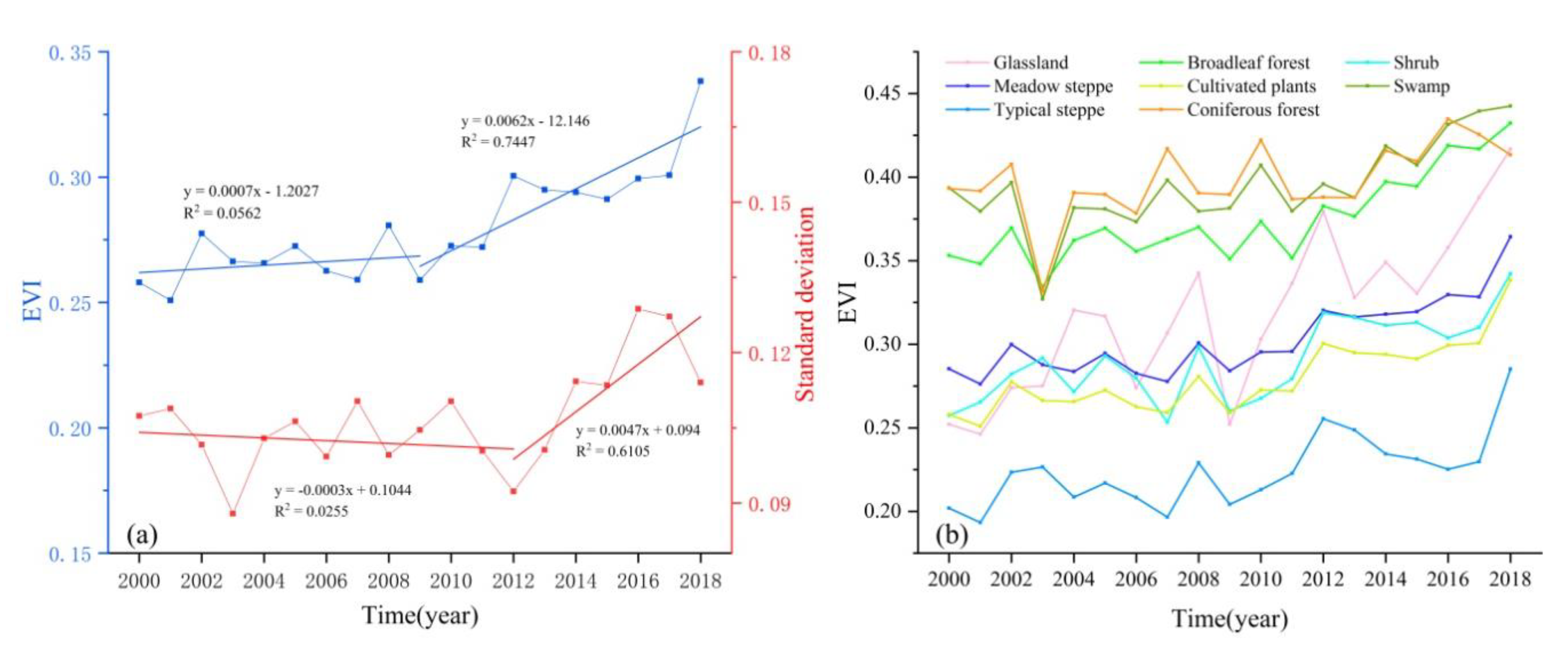

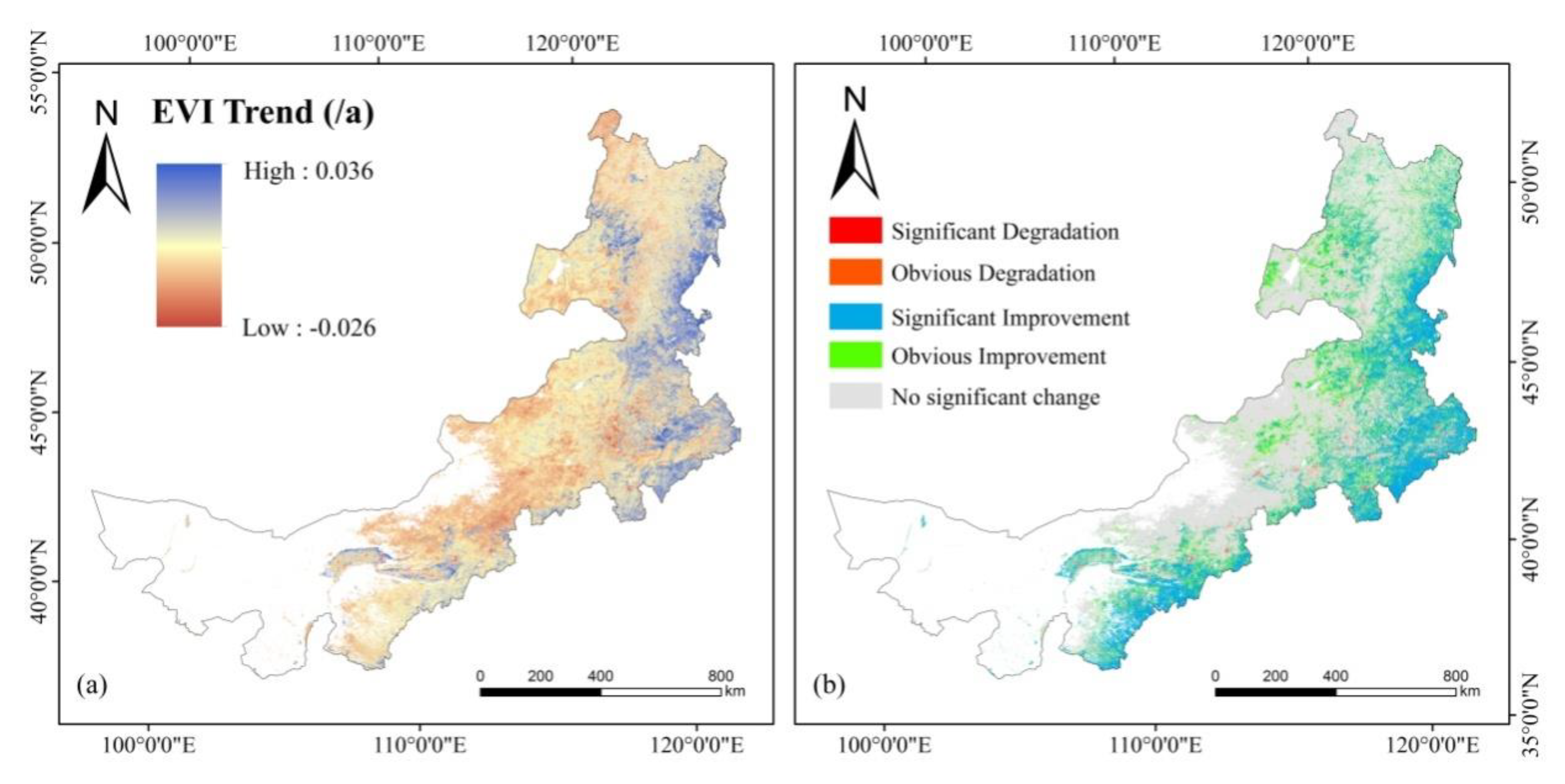
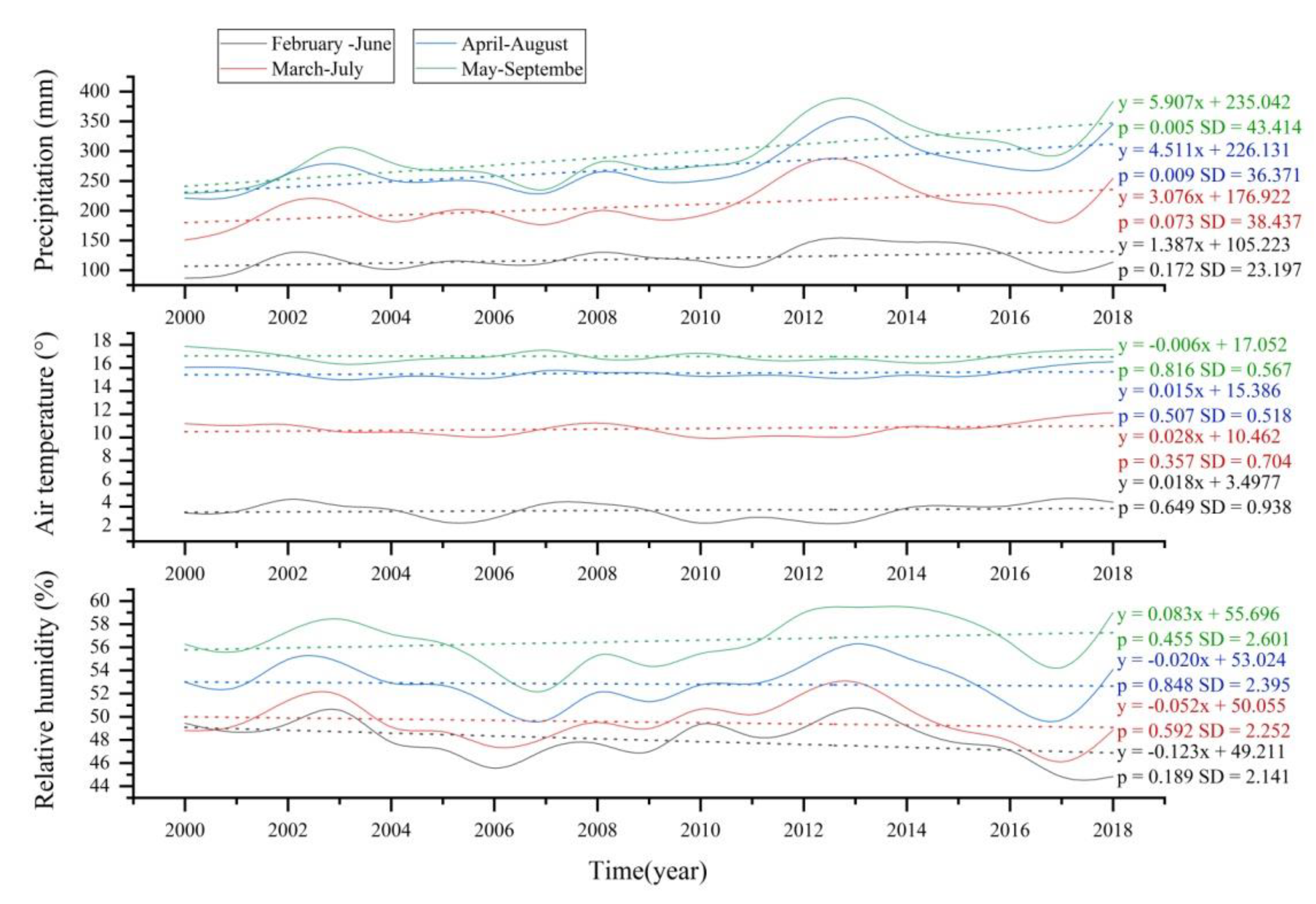

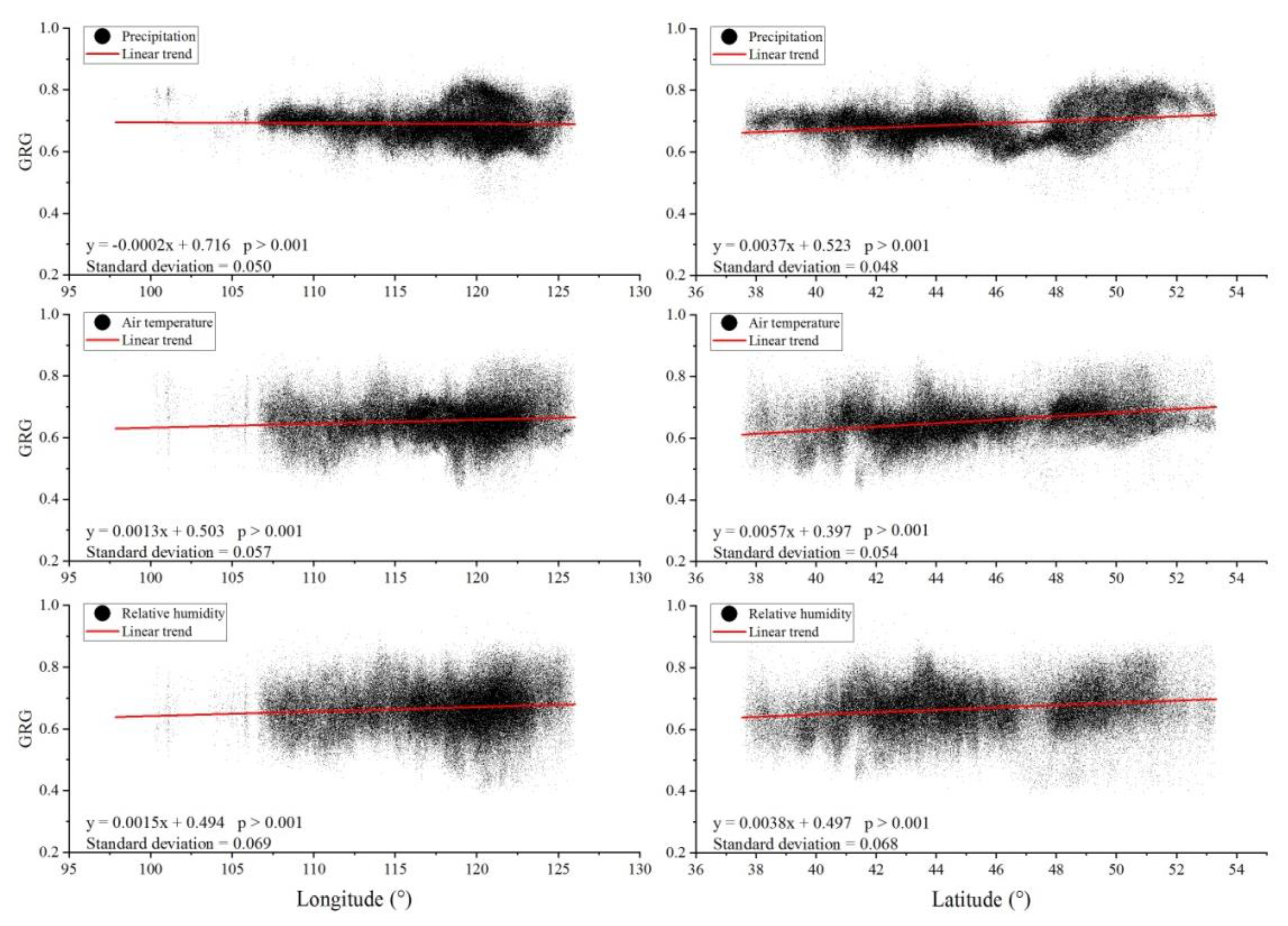
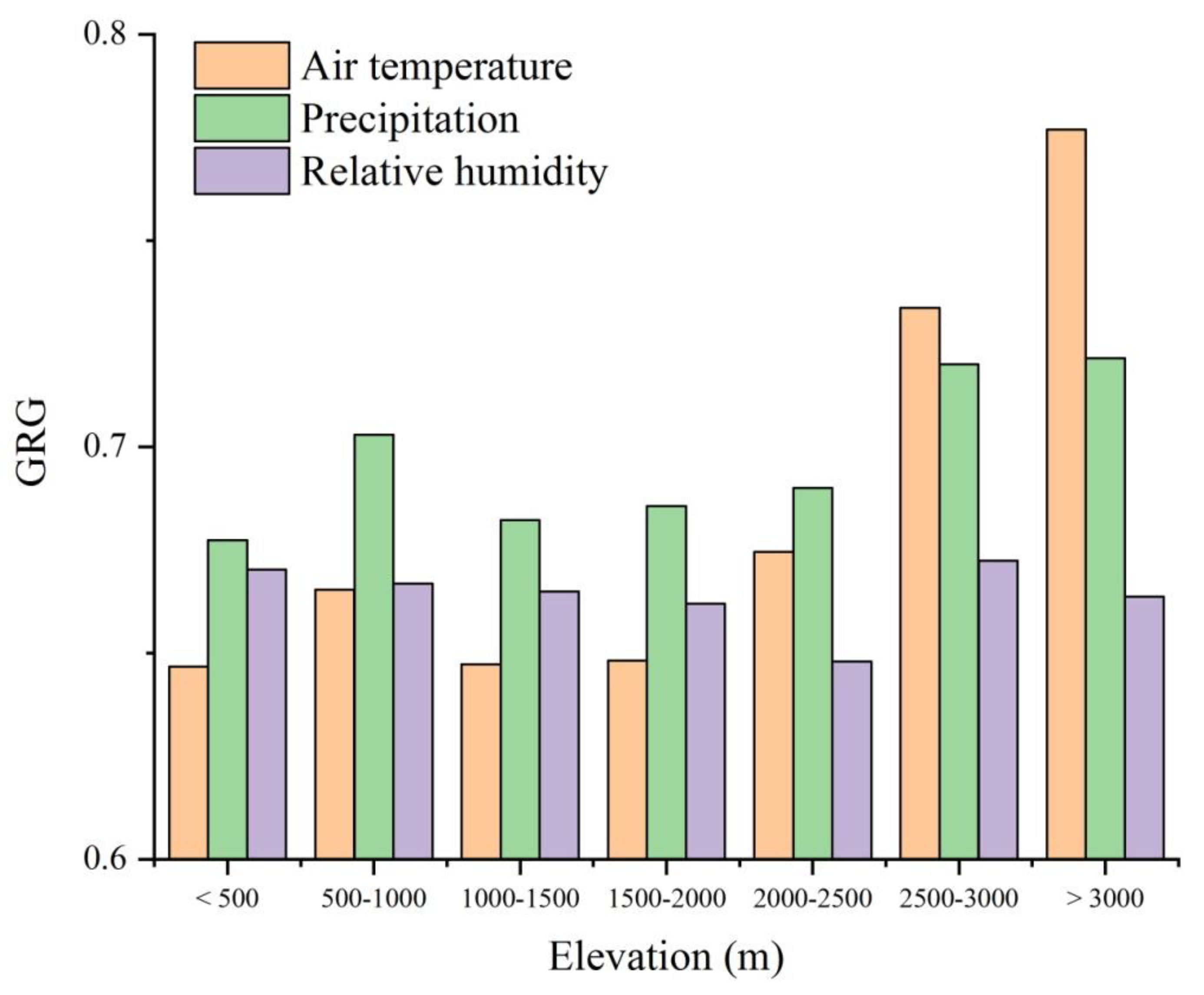
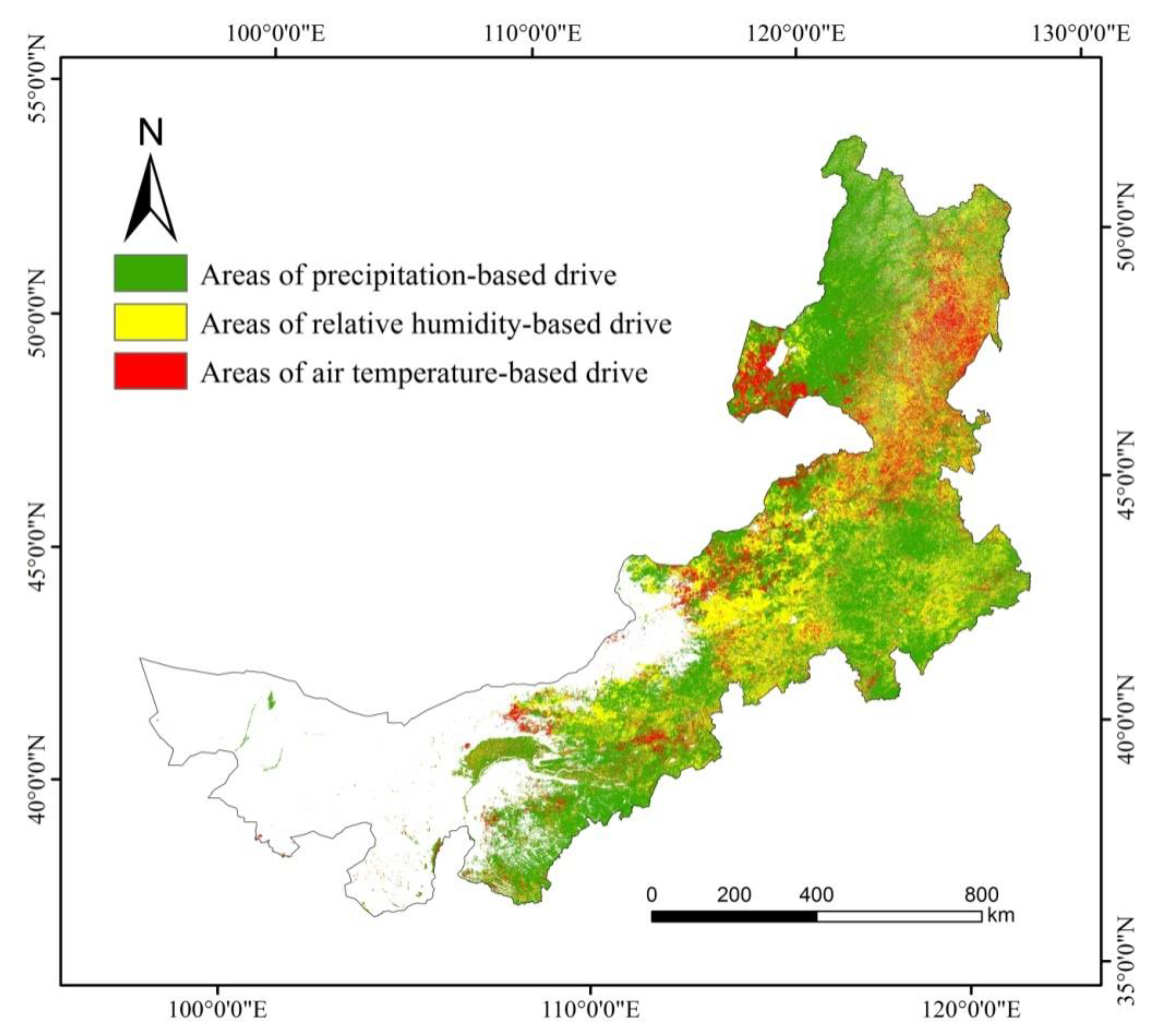
© 2020 by the authors. Licensee MDPI, Basel, Switzerland. This article is an open access article distributed under the terms and conditions of the Creative Commons Attribution (CC BY) license (http://creativecommons.org/licenses/by/4.0/).
Share and Cite
He, D.; Huang, X.; Tian, Q.; Zhang, Z. Changes in Vegetation Growth Dynamics and Relations with Climate in Inner Mongolia under More Strict Multiple Pre-Processing (2000–2018). Sustainability 2020, 12, 2534. https://doi.org/10.3390/su12062534
He D, Huang X, Tian Q, Zhang Z. Changes in Vegetation Growth Dynamics and Relations with Climate in Inner Mongolia under More Strict Multiple Pre-Processing (2000–2018). Sustainability. 2020; 12(6):2534. https://doi.org/10.3390/su12062534
Chicago/Turabian StyleHe, Dong, Xianglin Huang, Qingjiu Tian, and Zhichao Zhang. 2020. "Changes in Vegetation Growth Dynamics and Relations with Climate in Inner Mongolia under More Strict Multiple Pre-Processing (2000–2018)" Sustainability 12, no. 6: 2534. https://doi.org/10.3390/su12062534
APA StyleHe, D., Huang, X., Tian, Q., & Zhang, Z. (2020). Changes in Vegetation Growth Dynamics and Relations with Climate in Inner Mongolia under More Strict Multiple Pre-Processing (2000–2018). Sustainability, 12(6), 2534. https://doi.org/10.3390/su12062534




